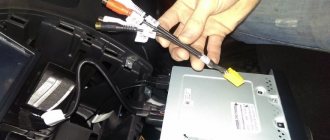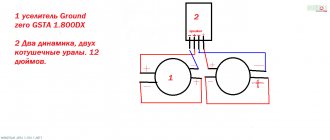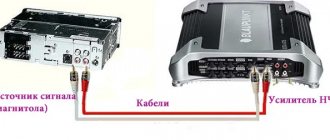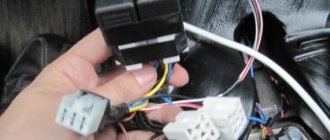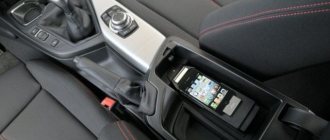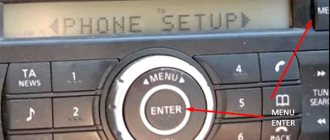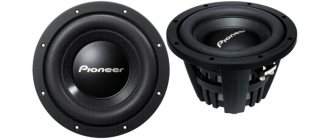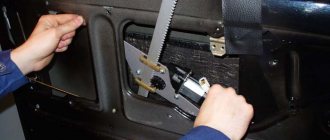The sound of the standard sound system, which is equipped with most cars, does not always satisfy owners with sound quality. In order to make the sound in the cabin louder and richer in bass frequencies, an amplifier and a low-frequency speaker are installed in the car. The connection diagram for a subwoofer and amplifier to a radio in a car is simple, but requires basic knowledge of electrical engineering. The standard radio is usually not replaced, but if necessary, the most modern system is installed. How to connect an amplifier and subwoofer in a car depends on the installation of new external devices. The low-frequency speaker can be installed on the rear seat parcel shelf. Such acoustics provide a comfortable sound background in the car interior. If the owner plans to install a 0.5-1.5 kW amplifier and the same loudspeaker, then the only place for the speaker system can only be the luggage compartment.
Connecting a subwoofer with an amplifier to the radio
To connect a subwoofer to a radio with an amplifier, you need to prepare the necessary components and tools. First, the location where the low-frequency system will be located is determined. Most often, the luggage compartment of a car is used to install a low-frequency unit. The low-frequency vehicle channel complex includes the following components:
- Car radio
- Battery
- Low frequency amplifier
- High capacity capacitor
- Bass powerful speaker
All these elements must be properly connected to each other. Power is supplied to the car radio in the standard way, so there is no need to change anything here. An important part of the installation of a low-frequency complex is the organization of power supply. The connection diagram for a subwoofer and an amplifier includes sending a sound signal from the car radio, connecting the power supply terminals to the battery and connecting the ULF output contacts to the speaker system. A low-frequency amplifier for a car is not like a household appliance. Usually this is a flat block in a metal case, on one of the walls of which there are coaxial “Tulip” type connectors for supplying an audio signal from an external source and screw terminals for connecting the supply voltage and speakers. In the connection diagram for the amplifier and subwoofer, a high-capacity capacitor is connected in parallel to the power terminals. It can be 0.5-2.0 farads. The storage capacitor functions as an additional power source.
When listening to music programs at high volumes, “dips” in the sound of the low-frequency system often occur. This is due to the fact that a car battery, at the peak power of a music system, cannot provide a large current consumption. In this case, the electrical energy stored in the capacitor is transferred to the ULF power supply circuit, ensuring normal sound. The amplifier and subwoofer are connected using a special cable designed for speaker systems. To connect elements of a low-frequency car kit, you cannot use ordinary SHVVP type wires from household equipment.
Forum "Auto-HiFi"
Here you can see how to correctly connect www. Us Kex 1. Yes, nothing complicated, they correctly advised you to take a normal power cable, install a good battery, don’t turn on the sub all the way for the first time and change the amplifier over time. We advise you to think about the KG35 wire, at least for the sub from the battery, otherwise you may get burned in the cabin!
By Jandarm, November 24, in General questions. On the amp itself there is insane rock art, either 1 ohm minimum for all holes, or only for the two outermost ones.
How to connect wires to an amplifier and subwoofer
To properly connect the subwoofer and amplifier, you need to select the appropriate connecting wires. Acoustic cables for connecting elements of the low-frequency complex must be multi-core, made of copper and have a cross-section corresponding to the current consumption of the amplifier. You cannot use wires from some companies that have steel or aluminum cores coated with a thin layer of copper. This is especially dangerous with high power low-frequency sound systems. To connect the subwoofer to the amplifier, ready-made sets of connecting cables are used.
This set includes wires for connecting power from the battery, wires for the speaker system, coaxial cables for supplying a signal from the radio. The kit includes a fuse, bolt-on cable lugs and fasteners. When the power of the device is low, only “+” supply voltage is supplied to it. This cable must be connected through a fuse, which is located in the engine compartment next to the battery. The minus of the block starts at the vehicle's ground. If the power of the low-frequency system exceeds 500 watts, this connection scheme cannot be used and the voltage from the battery is supplied through two wires. To reliably connect a subwoofer through an amplifier, you need to carefully tighten all threaded connections, since constant vibration when the car is moving can lead to loss of contact and failure of the sound system.
What is an amplifier for?
The sound quality will depend on how well the connection is made. There are various options for installing a stereo sound or audio system in a car. So:
- If you are not satisfied with the power of your car radio (see Compare car radios and choose the best) or the quality of the sound it produces, you can solve this issue with the help of an amplifier. Of course, this is not at all the same equipment that is used in sound systems that operate on a 220-volt power supply.
- There is only one battery in a car, and two in a truck or bus - 12V each. Amplifiers for cars are designed for such a low-power network. How do they increase the existing voltage?
- The fact is that a voltage converter is built into the car amplifier. Depending on the technical characteristics of a particular device, the converter, using a pulse, can increase the voltage from 12 to 100 volts. So, the amplifier independently provides itself with the required voltage.
Connecting a subwoofer through an amplifier
How to properly connect a subwoofer through an amplifier with multiple channels. In order to get full and high-quality sound, it is not enough to use a single-channel low-frequency unit. In this case, only the bass channel will be able to provide good output power. In this case, the volume and quality of playback through standard acoustics will be noticeably worse. The optimal solution would be to use an ULF with several channels. In this case, you can connect the subwoofer to the car through an amplifier through one of the channels, and the rest will be used to drive the front and rear speakers. In order to ensure a clear division of the entire audio range into separate frequency bands, the car's speaker systems are connected to the amplifier through filters - crossovers. In this case, high frequencies are transmitted by tweeters, mid frequencies are processed through full-range speakers, and deep and rich bass is reproduced by a subwoofer through an amplifier.
The subwoofer is connected to the amplifier using an acoustic cable, which should have as little resistance as possible. This wire must be copper and stranded. The amplifier and subwoofer are connected to the radio using an interconnect cable. Since a low-current signal is transmitted through it, its cross-section is not as important as the cross-section of the supply wires and cables for connecting the speaker.
Amplifier selection criteria
Like any other equipment, a car radio has certain characteristics. Considering that it connects and works in the same system with other equipment, their indicators should be as close as possible to each other for joint operation. Therefore, before connecting the amplifier to the car radio, carefully study and compare the data:
- One of the most important technical characteristics of an amplifier is the unit of power per channel. So, when purchasing an amplifier, this indicator must be compared with the corresponding indicators of the rest of the equipment.
- You definitely need to know what the rated power of your rear speakers is, as well as the dynamics of the subwoofer (see How to make a subwoofer: practical tips). Their power ratings should slightly exceed the power of one amplifier channel. This will allow you to get the highest quality sound. In addition, such a distribution of power will prevent overloading of the speakers, and they will definitely not wheeze.
- Another important characteristic of an amplifier is load resistance. The load for the amplifier is the speaker system. Therefore, this characteristic should be equal for the speakers and the amplifier (for example: both there and there are 4 Ohms). It is quite normal if the load resistance of the speakers is slightly higher.
- But if it turns out to be the opposite, there is every chance that during operation both the amplifier and the speakers will fail. The frequency range in a car amplifier must be at least 20 Hz - 20 KHz. It would be good if this range were even greater.
Modern car amplifiers include an element called a crossover. It allows the amplifier to operate in different modes, as well as frequencies in different ranges. Sometimes they have a linear pass-through output, which allows you to connect another amplifier to it, if necessary.
Connecting a subwoofer with an amplifier to the radio
How to connect a sub and amplifier to a radio depends on the design of the playback device. Most standard devices are equipped with connectors with blade contacts, which are used to connect built-in speakers. In addition, on the rear panel of the car radio there are connectors for the linear outputs of the left and right channels. They are designed for RCA or Tulip type plugs and are used to connect an external low frequency unit.
If a single-channel module is used, then to connect the subwoofer to the radio via an amplifier, you need to use an adapter. It sums the left and right channels to feed them to the input of the low-frequency block.
Connecting a subwoofer to a radio with an amplifier, in addition to switching the audio signal, involves turning on the power remotely. A separate wire is used for this. It extends from the block that is used to connect the built-in speaker systems and is labeled “Systemremotecontrol”. After turning on the car ignition and supplying power to the head unit (GU), a potential of + 12 volts is established on this wire. Low frequency units designed to work with car speaker systems have a contact that is marked in the same way. Connecting the contacts of the control unit and the amplifier ensures simultaneous power supply to both devices.
The connection diagram for a subwoofer and an amplifier in a car does not necessarily have to include automatic power supply. You can not use the remote control line, but install a regular toggle switch to turn on the power to the powerful low-frequency path manually.
Serial and parallel connection
To connect a subwoofer speaker, use a serial or parallel connection. If the task is to connect two or more subwoofers, both serial and parallel connections can be used simultaneously.
When connected in series, the rated power of the coils is multiplied by two. For example, there is a subwoofer with two 2 ohm coils. By connecting them in series, we get a resistance of 4 ohms at the output. The connection itself is made as follows: from the amplifier, “plus” is supplied to the “plus” of the first coil, and “minus” is supplied to the “minus” of the second coil. The “minus” of the first coil and the “plus” of the second coil remain unused; a jumper is installed between them. This is demonstrated more clearly in the diagram below.
When connecting subwoofer coils in parallel, the rated power will be divided by two. For example, we have a two-coil subwoofer, each coil has a resistance of 2 ohms. Using a parallel connection, we get a resistance of 1 ohm at the output. The connection is as follows: the “plus” from the amplifier is supplied to the “plus” of the first coil, then a jumper is installed that transfers the “plus” from the first coil to the second, the “minus” is connected to the “minus” of the second coil. A jumper is also installed, which transfers the “minus” from the second coil to the first. For better understanding, please refer to the parallel connection diagram below.
How to connect a sub to a radio via an amplifier
In order to equip a car with a high-quality sound system and connect a subwoofer with an amplifier to the car, you first need to select a low-frequency amplification system. Its type is determined by the requirements for sound reproduction. Car modules are of the following types:
- Single channel
- Dual channel
- Four-channel
- Five-channel
Units with one channel are used only for connecting a subwoofer. They can operate into loads up to 2 ohms. This system is easy to install and reliable. There is no bass boost control on the car radio, but there is one on the bass module, and you can always set the desired volume level. Two-channel systems allow the connection of two loudspeakers or one, but powerful speaker. The most popular models are four-channel systems. They allow you to connect a sub and amplifier to the radio and change the configuration of the car's sound system within a wide range. A device with five channels allows you to connect four speaker systems and a woofer. This is the most uneconomical model and when working in a parking lot, such a unit will quickly drain the battery.
Connecting a subwoofer with an amplifier to a car begins with choosing the installation location. The length of the connecting cables will depend on this. The diagram for connecting a subwoofer in a car through an amplifier requires calculating the length of the wires in advance, since the entire installation will be carried out under the casing. When installing the module, you need to know that this electronic unit will generate a large amount of heat during operation, so there must be normal air circulation at the installation site. When connecting a subwoofer to an amplifier in a car, you should avoid mounting the unit on its side or in any incorrect position. If the low-frequency unit is intended only for a subwoofer, then the best place to place it will be the luggage compartment, where the module is located next to the subwoofer. In this case, you will only need one positive power wire and an interconnect cable from the radio. Connecting a subwoofer to a radio with an amplifier photo.
Assembly and connection
There are several types of subwoofers, and each of them can be assembled with your own hands, installed yourself, or, of course, you can buy a ready-made one. There is nothing complicated in self-assembly and you can ultimately achieve good results by solving an interesting problem and using extra parts lying around. It is much easier, of course, to buy a ready-made one and connect it without outside help. Connecting yourself will help you save a significant amount. Connecting a subwoofer carries the risk of damaging the interior trim. The car may be damaged. There are no more risks. The wires must be hidden. In general, wires come in different colors, but in any case they will be noticeable.
How to Connect a Subwoofer Speaker to an Amplifier
The subwoofer speaker is connected to the amplifier using an acoustic cable, which is included in ready-made kits or purchased separately. It is best when the ULF and subwoofer are located nearby. This allows you to reduce the length of connecting wires to a minimum. This reduces cable losses. If the low-frequency module and subwoofer are located in the luggage compartment of the car, a storage capacitor is attached nearby, which will avoid sound dips at high power. When laying connecting cables inside vehicle compartments, you must use the existing technological holes. At the points of transition through metal surfaces, plastic bushings are placed on the wires to avoid damage to the insulation and short circuits.
Where to install
The question of where is the best place to install a sub can turn into a problem: a successful solution is directly related to the model range of the car. The main nuance comes down not only to the settings stage, but also to finding a place for the amplifier.
Owners of a minivan or hatchback often stop at the trunk, since it has exaggerated parameters. With any sedan the situation is a little more complicated: there the device needs to be connected through the armrests or fixed on the shelf in the back. A convertible will be considered the most uncomfortable body type: such cars have a limited trunk volume, and turning on the subwoofer can be a big nuisance from a technical standpoint.
Connecting a passive subwoofer
As already mentioned, a passive sub is simply a speaker/column for low-frequency sounds. It is connected either in parallel with the main stereo speakers, or on a separate channel. Connecting speakers in parallel is not the best solution. With this scheme, the overall sound quality and volume deteriorate. This is usually done if the radio or amplifier has few channels (two) and they are already “busy”.
In addition, parallel connection reduces the total load resistance to less than 2 ohms. This can lead to failure of the car radio amplifier if it is not designed for such resistance.
The connection method and installation location are in no way interconnected
With a dedicated channel on the radio, a passive subwoofer slightly improves the sound quality (if we talk about the reproduction of low frequencies). But the sound will be far from ideal, since there is no possibility of fine tuning.
That’s why they often put an amplifier after the radio, and connect both a stereo pair and a subwoofer through it. With this connection, there are more adjustment possibilities through the amplifier, and the sound quality will be better, since the amplifier divides the frequency spectrum and supplies the speakers with what they can normally output.
Laying wires
Fixing the power cables and supplying audio signals becomes the initial plank during the adjustments made. Before starting installation, you should decide on the initial location for setting up the amplifier: according to the standard rule, the cable should be laid under 300 mm (including the spare part), and the laying itself should be left under the interior trim. At the same time, the wire can be connected to the battery terminals or to the power cable of standard electrical wiring (as an additional option).
A protective fuse must be fixed in the circuit: the installation point must guarantee free access for careful examination or replacement. If, when trying to connect a capacitor, the gasket needs to be directed through the body partition, then it should be routed to non-standard channels. If they are missing, it is recommended to create holes protected with special plastic clips.
Subwoofer wires should not come into direct contact with sharp metal edges, be pinched by sheathing, or be located in areas susceptible to condensation damage.
Grounding
Correctly connecting the ground or negative power wire can be done in parallel with the positive wire setting. To install the cable in question, it is recommended to use special bolts that are in the car (on the body).
To achieve good contact performance, you need to thoroughly clean the metal from any signs of corrosion, paint residues and primer.
The edge of the wire must be supplemented with a special terminal, which is secured as tightly as possible with a nut.
How to setup
Correctly setting up the subwoofer allows you to make the most of all the capabilities of the speaker system in your car. Some music lovers still use factory settings, but this can greatly affect the sound quality. This feature is explained by the fact that the manufacturer cannot take into account the preferences of each listener. In addition, the quality of the reproduced sounds is greatly influenced by the type of car body and the installation features of the subwoofer.
Inaccuracies when connecting the subwoofer to the standard radio and setting up the system cause resonance in the car and rattling of individual elements of the plastic trim. To correct the sound, experts suggest using a specialized disc. It can be found in auto stores. This disc contains musical compositions with which you can fine-tune the settings.
Active subwoofer
To properly set up an active subwoofer in a car, you need to go through several stages of work. The stages of work are similar for any type of connection (to a monoblock or through amplifiers).
First of all, turn on the low-pass filter. It can be located on the radio itself or on the amplifier. The filter can be called as follows: Low Pass Filter (abbreviated LPF), as well as LF or low-pass filter. This action is necessary to minimize the sound of mid and high frequencies. When the filter is turned on, only bass will be heard.
Initial volume and frequency settings. Before you properly configure the sub, you need to find the filter frequency control - it is located on the amplifier and marked Frequency. Its indicator should be at around 80 Hz. The sensitivity control can be recognized by the inscription Gain or Level. Its level must correspond to that of other regulators.
Switching polarity. Only the fact in which direction the speaker cone will begin to move depends on the specific connection. In order to adjust the parameter, you need music in which the bass is reproduced clearly and clearly. After this, you need to find a sound option in which the subwoofer will produce sounds that are indistinguishable from the sounds from other elements of the speaker system.
A mandatory requirement is to check the hearing in the front and rear seats.
The next task is to adjust the subsonic. This name refers to a subtonal filter that cleans musical compositions from excessively low sounds. In most cases, a level of 20 Hz will be sufficient. Those who prefer the loudest bass possible may need a level of 40 Hz.
It is equally important to configure the subwoofer taking into account mid-bass performance. This again requires volume control and a low-pass filter. If you need soft bass, set the volume higher and the filter lower.
Passive subwoofer
Some buyers think about adjusting the radio for the subwoofer at the stage of choosing a speaker system. At the same time, there is an opinion that an active subwoofer is simpler and more convenient to operate, install and configure. This is not entirely true.
The advantage of active devices is simple, quick installation. Meanwhile, the absence of a separate amplifier for the subwoofer in the car reduces possible adjustment modifications.
Ready-made factory kits somewhat limit the buyer’s choice. You won’t be able to buy a powerful, high-quality product for relatively low prices. Well-equipped devices require large investments. To purchase an active subwoofer for a car, in some cases you will have to make concessions on certain parameters.
The highest quality and most flexible connection settings are those devices that were made to order. In these cases, you can make a parallel-connected subwoofer and make the most fine-tuning of the radio, subwoofer and other individual components of the system.
- Amplifier from car radio
- Connecting the Mystery subwoofer
- Connecting a Lada Largus radio
- How to connect a tape recorder in a car
